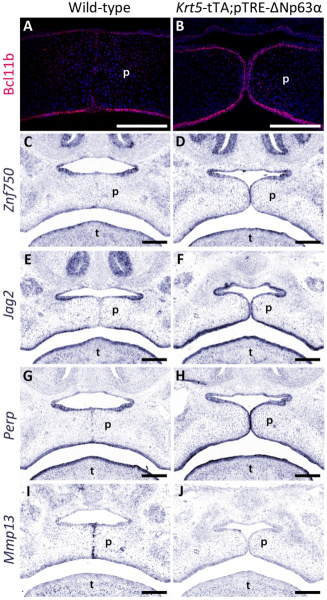File:Mouse palate increasing p63.jpg

Original file (654 × 1,199 pixels, file size: 314 KB, MIME type: image/jpeg)
Molecular consequences of increasing p63 expression during palatal development
(A, B) The expression of Bcl11b (A, B), Znf750 (C, D), Jag2 (E,F) and Perp (G, H), all of which are down-regulated in the medial edge epithelia of wild-type mice, is maintained in the medial edge epithelia of their Krt5-tTA;pTRE-ΔNp63α bi-transgenic littermates. In contrast, Mmp13 which is normally expressed in the midline epithelial seam of wild-type mice as they adhere until degeneration of the seam, is down-regulated in the medial edge epithelia of Krt5-tTA;pTRE-ΔNp63α embryos. p: palatal shelves; t: tongue. Scale bars: 200 μm.
Cleft palate is a common congenital disorder that affects up to 1 in 2500 live births and results in considerable morbidity to affected individuals and their families. The aetiology of cleft palate is complex with both genetic and environmental factors implicated. Mutations in the transcription factor p63 are one of the major individual causes of cleft palate; however, the gene regulatory networks in which p63 functions remain only partially characterized. Our findings demonstrate that p63 functions as an essential regulatory molecule in the spatio-temporal control of palatal epithelial cell fate to ensure appropriate fusion of the palatal shelves. Initially, p63 induces periderm formation and controls its subsequent maintenance to prevent premature adhesion between adhesion-competent, intra-oral epithelia. Subsequently, TGFβ3-induced down-regulation of p63 in the medial edge epithelia of the palatal shelves is a pre-requisite for palatal fusion by facilitating periderm migration from, and reducing the proliferative potential of, the midline epithelial seam thereby preventing cleft palate.
Reference
Richardson R, Mitchell K, Hammond NL, Mollo MR, Kouwenhoven EN, Wyatt ND, Donaldson IJ, Zeef L, Burgis T, Blance R, van Heeringen SJ, Stunnenberg HG, Zhou H, Missero C, Romano RA, Sinha S, Dixon MJ & Dixon J. (2017). p63 exerts spatio-temporal control of palatal epithelial cell fate to prevent cleft palate. PLoS Genet. , 13, e1006828. PMID: 28604778 DOI.
Copyright
© 2017 Richardson et al. This is an open access article distributed under the terms of the Creative Commons Attribution License, which permits unrestricted use, distribution, and reproduction in any medium, provided the original author and source are credited.
Pgen.1006828.g007.jpg
Cite this page: Hill, M.A. (2024, April 26) Embryology Mouse palate increasing p63.jpg. Retrieved from https://embryology.med.unsw.edu.au/embryology/index.php/File:Mouse_palate_increasing_p63.jpg
- © Dr Mark Hill 2024, UNSW Embryology ISBN: 978 0 7334 2609 4 - UNSW CRICOS Provider Code No. 00098G
File history
Click on a date/time to view the file as it appeared at that time.
| Date/Time | Thumbnail | Dimensions | User | Comment | |
|---|---|---|---|---|---|
| current | 10:52, 22 October 2018 |  | 654 × 1,199 (314 KB) | Z8600021 (talk | contribs) | Molecular consequences of increasing p63 expression during palatal development (A, B) The expression of Bcl11b (A, B), Znf750 (C, D), Jag2 (E,F) and Perp (G, H), all of which are down-regulated in the medial edge epithelia of wild-type mice, is mainta... |
You cannot overwrite this file.
File usage
There are no pages that use this file.